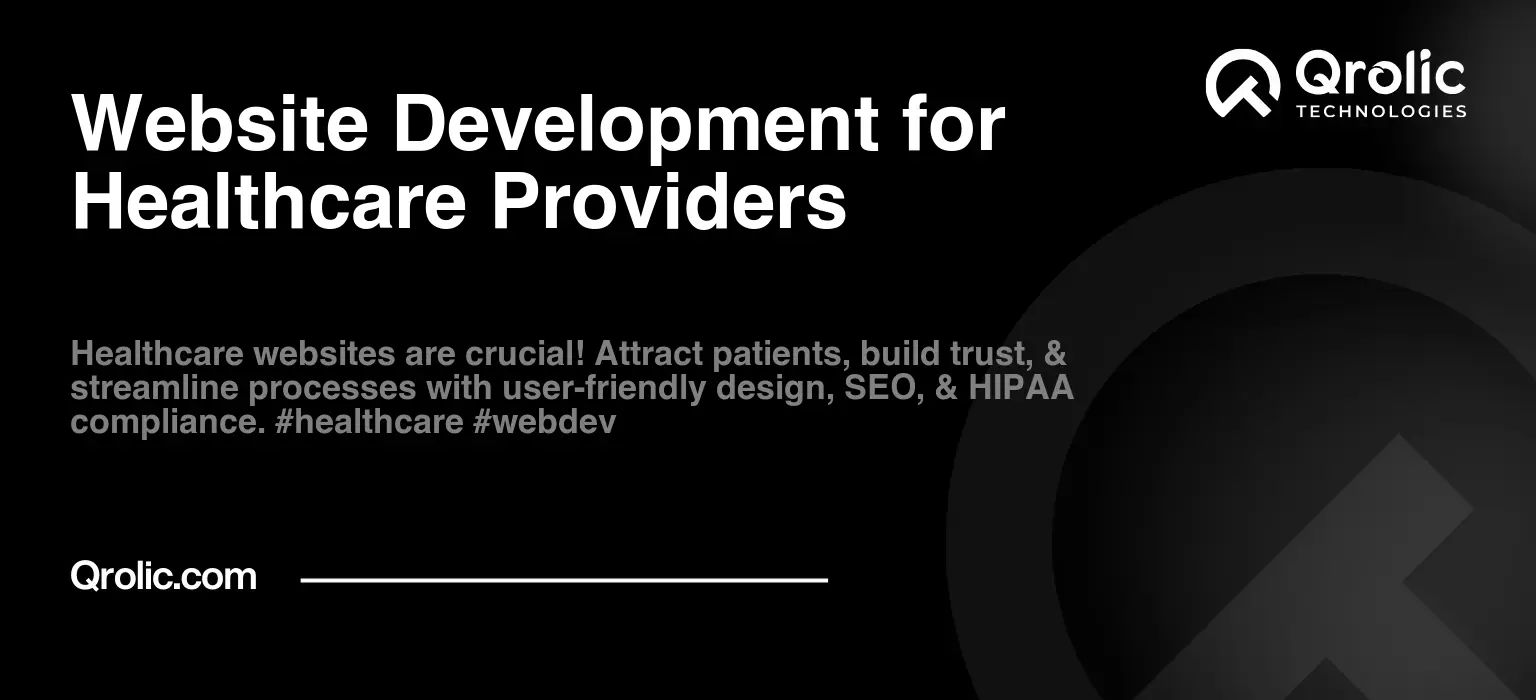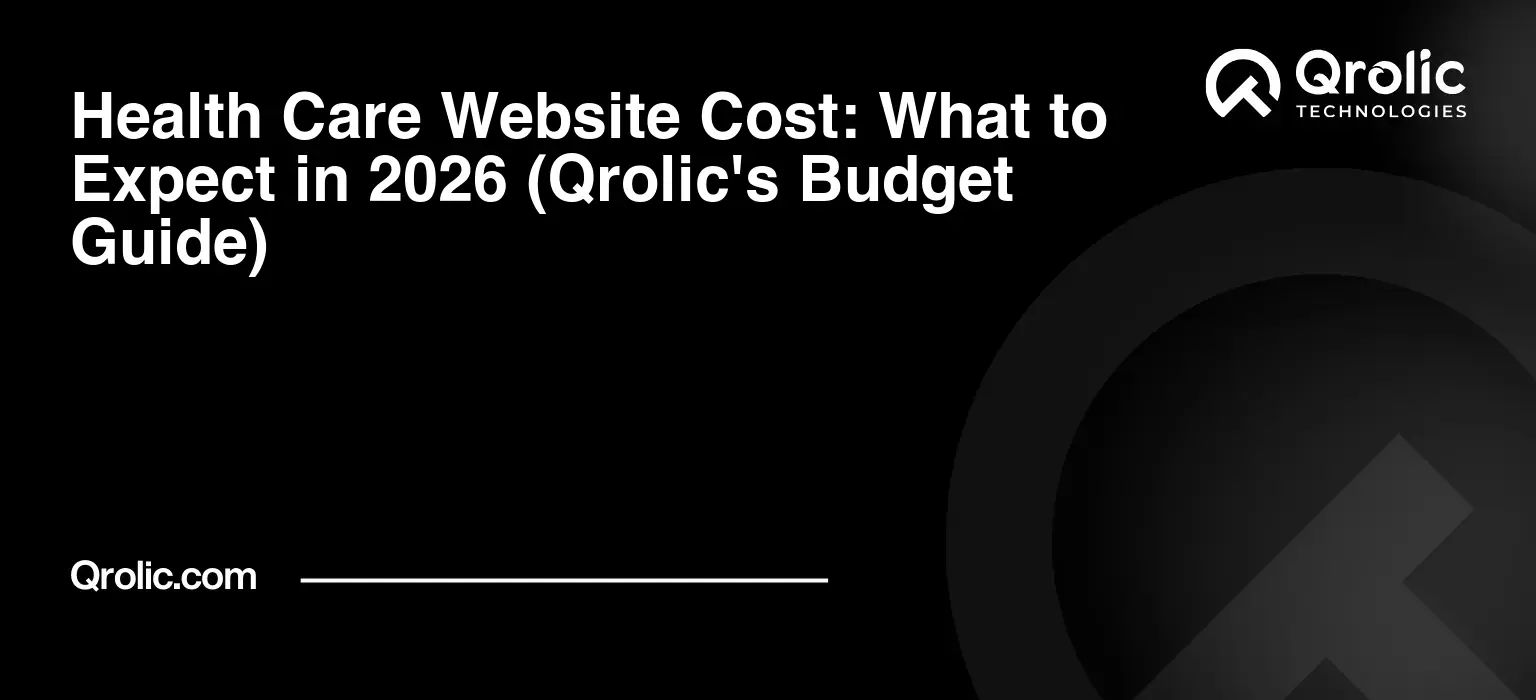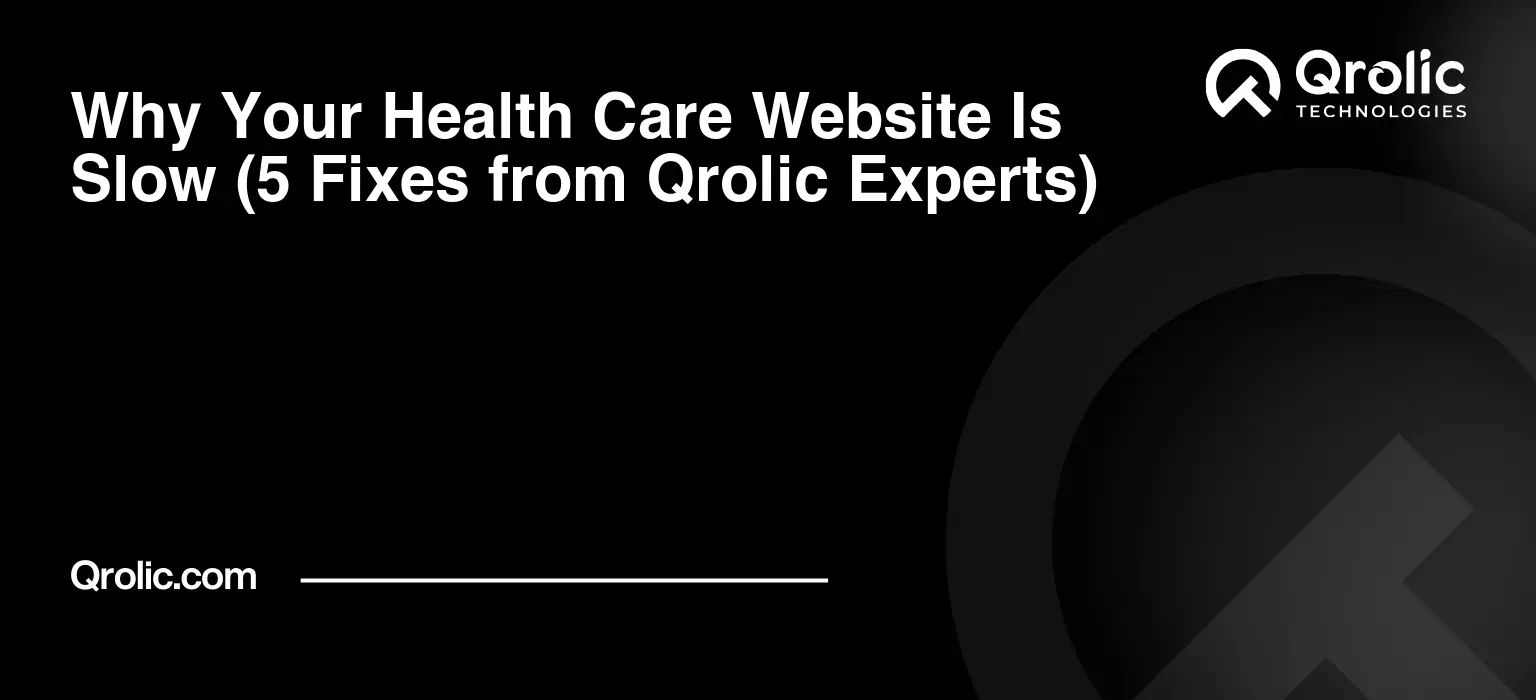Quick Summary:
- Your website is essential; it’s your virtual front door.
- Focus on user-friendly design, great content, and SEO.
- Ensure strict security and HIPAA compliance for trust.
- Choose experienced partners who understand healthcare web needs.
Table of Contents
- Why Your Healthcare Practice Needs a Stellar Website: More Than Just an Online Brochure
- The Patient’s Journey Begins Online: From Search to Appointment
- Benefits of Investing in a Professional Healthcare Website
- Key Elements of an Effective Healthcare Website: Building Trust and Delivering Value
- 1. User-Centric Design: Putting Patients First
- 2. Informative and Engaging Content: Educating and Reassuring Patients
- 3. Search Engine Optimization (SEO): Getting Found Online
- 4. Online Appointment Scheduling: Streamlining the Patient Experience
- 5. Patient Portal: Enhancing Patient Engagement
- 6. High-Quality Visuals: Creating a Positive First Impression
- 7. Security and HIPAA Compliance: Protecting Patient Information
- The Website Development Process: From Planning to Launch
- 1. Planning and Discovery: Defining Your Goals and Target Audience
- 2. Design and Content Creation: Building the Look and Feel of Your Website
- 3. Development: Bringing Your Website to Life
- 4. Testing and Quality Assurance: Ensuring a Flawless User Experience
- 5. Launch and Promotion: Getting Your Website Seen
- 6. Maintenance and Updates: Keeping Your Website Fresh and Secure
- Choosing the Right Website Development Partner: Expertise and Experience Matter
- What to Look for in a Healthcare Website Development Agency
- Questions to Ask Potential Website Development Partners
- Qrolic Technologies: Your Partner in Healthcare Website Development
- Why Choose Qrolic Technologies for Your Healthcare Website?
- Our Healthcare Website Development Services Include:
- The Future of Healthcare Websites: Trends to Watch
Why Your Healthcare Practice Needs a Stellar Website: More Than Just an Online Brochure
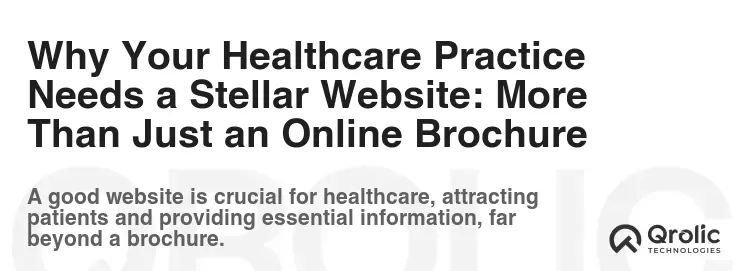
In today’s digital landscape, a website is more than just a digital brochure for your healthcare practice. It’s the virtual front door to your clinic, hospital, or private practice. It’s where potential patients form their first impressions, research your services, and decide whether or not you’re the right fit for their healthcare needs. Think of it as your 24/7 receptionist, patiently answering questions and guiding visitors toward becoming patients. Neglecting your online presence is like closing your physical doors after hours – you’re missing out on valuable opportunities.
The Patient’s Journey Begins Online: From Search to Appointment
The patient journey now almost always starts online. A potential patient might be experiencing symptoms and turning to Google for answers. If your website isn’t optimized for search engines, or if it offers a poor user experience, they’ll likely click away to a competitor who’s easier to find and more informative.
Here’s a typical scenario:
- Symptom Search: A person searches online for “headache relief near me.”
- Website Discovery: Your website appears in the search results.
- Information Gathering: They browse your site to learn about your services, your expertise, and your approach to patient care.
- Trust Building: They read patient testimonials and reviews.
- Decision Time: Based on their experience on your website, they decide whether or not to contact your practice.
- Appointment Booking: They schedule an appointment online or call your office.
A well-designed and informative website can significantly impact each stage of this journey, turning online searchers into loyal patients.
Benefits of Investing in a Professional Healthcare Website
Investing in a professional website specifically designed for healthcare providers offers a multitude of benefits:
- Increased Visibility: A well-optimized website helps you rank higher in search results, making it easier for potential patients to find you.
- Enhanced Credibility: A professional-looking website builds trust and confidence in your practice.
- Improved Patient Experience: A user-friendly website makes it easy for patients to find information, book appointments, and access resources.
- Streamlined Operations: Online appointment scheduling, patient portals, and online forms can save time and resources for your staff.
- Expanded Reach: A website allows you to reach patients beyond your immediate geographic area.
- Better Patient Education: You can use your website to provide valuable information about health conditions, treatments, and preventive care.
- Competitive Advantage: A strong online presence sets you apart from competitors who haven’t invested in their websites.
- Cost-Effective Marketing: Compared to traditional advertising, a website is a relatively affordable and effective marketing tool.
- 24/7 Availability: Your website is always available to answer questions and provide information, even outside of office hours.
- Data-Driven Insights: Website analytics provide valuable data about patient behavior and preferences, allowing you to optimize your website and marketing efforts.
Key Elements of an Effective Healthcare Website: Building Trust and Delivering Value
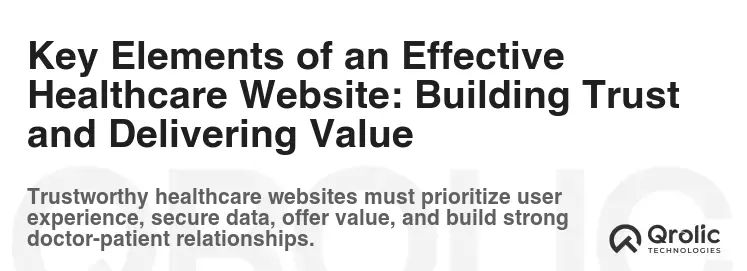
Creating a successful healthcare website involves carefully considering several key elements:
1. User-Centric Design: Putting Patients First
What is it? User-centric design focuses on creating a website that is easy to use, intuitive, and meets the needs of your target audience.
Why is it important? A user-friendly website keeps visitors engaged and encourages them to explore your services. A confusing or frustrating website will drive them away.
How to implement it:
- Simple Navigation: Make it easy for visitors to find what they’re looking for. Use clear and concise menu labels and a logical site structure.
- Mobile-First Design: Ensure your website is responsive and looks great on all devices, especially smartphones. A significant portion of your website traffic will come from mobile devices.
- Fast Loading Speed: Optimize your website for speed to prevent visitors from getting impatient and leaving. Use optimized images and efficient coding.
- Accessibility: Make your website accessible to people with disabilities. Follow accessibility guidelines (WCAG) to ensure everyone can use your site.
- Clear Call to Actions: Guide visitors toward desired actions, such as booking an appointment or contacting your office. Use prominent buttons and clear language.
2. Informative and Engaging Content: Educating and Reassuring Patients
What is it? High-quality content that provides valuable information to your target audience.
Why is it important? Content is king. Informative and engaging content builds trust, establishes your expertise, and improves your search engine ranking.
How to implement it:
- Service Pages: Clearly describe your services, including what they are, how they work, and who they are for.
- About Us Page: Introduce your team, highlight your qualifications, and share your mission and values. This helps personalize your practice and build trust.
- Blog: Regularly publish articles on health-related topics relevant to your target audience. This demonstrates your expertise and improves your search engine ranking.
- Patient Testimonials: Share positive feedback from satisfied patients. This provides social proof and reassures potential patients.
- Frequently Asked Questions (FAQ): Answer common questions about your practice, your services, and your billing policies.
- Medical Information Disclaimer: Always include a disclaimer stating that the information on your website is for educational purposes only and should not be considered medical advice.
3. Search Engine Optimization (SEO): Getting Found Online
What is it? optimizing your website to rank higher in search engine results.
Why is it important? SEO is crucial for attracting organic traffic to your website. If people can’t find you on Google, they can’t become your patients.
How to implement it:
- Keyword Research: Identify the keywords that your target audience is using to search for healthcare providers in your area. Tools like Google Keyword Planner, SEMrush, and Ahrefs can help with keyword research. Focus on keywords like “healthcare website development”, “medical website design services”, and “clinic web design” and related long-tail keywords.
- On-Page Optimization: Optimize your website content, meta descriptions, and title tags with relevant keywords.
- Off-Page Optimization: Build high-quality backlinks from other reputable websites.
- Local SEO: Optimize your website for local search by claiming your Google My Business listing and encouraging patients to leave reviews.
- Technical SEO: Ensure your website is technically sound and easy for search engines to crawl and index. This includes having a sitemap, using HTTPS, and optimizing your website for mobile devices.
4. Online Appointment Scheduling: Streamlining the Patient Experience
What is it? Allowing patients to book appointments online, 24/7.
Why is it important? Online appointment scheduling saves time for both patients and staff, and it makes it easier for patients to book appointments when it’s convenient for them.
How to implement it:
- Integrate with your EMR: Integrate your online scheduling system with your electronic medical record (EMR) system to avoid double bookings and streamline patient information.
- User-Friendly Interface: Make the scheduling process easy and intuitive.
- Confirmation Emails: Send confirmation emails to patients after they book an appointment.
- Reminders: Send appointment reminders to reduce no-shows.
5. Patient Portal: Enhancing Patient Engagement
What is it? A secure online portal where patients can access their medical records, communicate with their providers, and manage their health information.
Why is it important? Patient portals empower patients to take control of their health and improve communication with their healthcare providers.
How to implement it:
- HIPAA Compliance: Ensure your patient portal is HIPAA compliant to protect patient privacy.
- Easy Access: Make it easy for patients to access their portal from your website.
- Secure Messaging: Allow patients to securely message their providers with questions and concerns.
- Access to Medical Records: Provide patients with access to their medical records, including lab results, medication lists, and appointment summaries.
- Online Bill Payment: Allow patients to pay their bills online.
6. High-Quality Visuals: Creating a Positive First Impression
What is it? Using professional photos and videos to enhance your website’s visual appeal.
Why is it important? High-quality visuals can make your website more engaging and build trust with potential patients.
How to implement it:
- Professional Photography: Use professional photos of your team, your office, and your services.
- Videos: Create videos that introduce your team, explain your services, and share patient testimonials.
- Optimized Images: Optimize your images for web to ensure they load quickly without sacrificing quality.
- Avoid Stock Photos: If possible, avoid generic stock photos and use original images that are specific to your practice.
7. Security and HIPAA Compliance: Protecting Patient Information
What is it? Implementing security measures to protect patient information and comply with HIPAA regulations.
Why is it important? Protecting patient privacy is essential for maintaining trust and avoiding legal penalties.
How to implement it:
- SSL Certificate: Use an SSL certificate to encrypt data transmitted between your website and your visitors’ browsers.
- Strong Passwords: Use strong passwords for all website accounts.
- Regular Security Audits: Conduct regular security audits to identify and address potential vulnerabilities.
- HIPAA Compliance Training: Train your staff on HIPAA compliance regulations.
- Business Associate Agreements (BAA): Ensure you have Business Associate Agreements (BAA) in place with any third-party vendors who have access to patient information.
The Website Development Process: From Planning to Launch
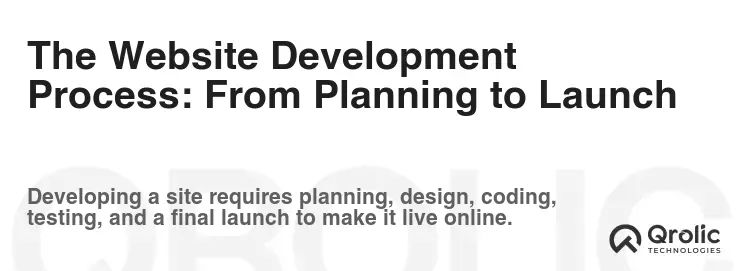
Developing a healthcare website is a multi-step process that requires careful planning and execution:
1. Planning and Discovery: Defining Your Goals and Target Audience
What is it? The initial phase of website development, where you define your goals, target audience, and website requirements.
Why is it important? A well-defined plan ensures that your website meets your needs and effectively serves your target audience.
Steps:
- Define Your Goals: What do you want to achieve with your website? Do you want to attract new patients, improve patient engagement, or streamline operations?
- Identify Your Target Audience: Who are you trying to reach with your website? What are their needs and expectations?
- Conduct a Competitive Analysis: Research your competitors’ websites to see what they’re doing well and where they could improve.
- Develop a Site Map: Create a visual representation of your website’s structure and content.
- Define Your Budget: Determine how much you’re willing to spend on website development.
2. Design and Content Creation: Building the Look and Feel of Your Website
What is it? Creating the visual design and writing the content for your website.
Why is it important? A well-designed website with compelling content can attract and engage potential patients.
Steps:
- Wireframing: Create wireframes to map out the layout and functionality of each page.
- Visual Design: Design the look and feel of your website, including the color scheme, typography, and imagery.
- Content Writing: Write clear, concise, and informative content for each page of your website.
- Image Selection: Select high-quality images that are relevant to your content.
3. Development: Bringing Your Website to Life
What is it? Building the website based on the design and content.
Why is it important? The development phase is where your website comes to life.
Steps:
- Coding: Write the code for your website using HTML, CSS, and JavaScript.
- CMS Integration: Integrate your website with a content management system (CMS), such as wordpress, to make it easy to manage and update your content.
- Plugin Installation: Install plugins to add functionality to your website, such as online appointment scheduling, patient portals, and contact forms.
- Testing: Thoroughly test your website to ensure it is functioning properly and is free of errors.
4. Testing and Quality Assurance: Ensuring a Flawless User Experience
What is it? Testing your website to identify and fix any bugs or issues.
Why is it important? Thorough testing ensures that your website provides a seamless and user-friendly experience.
Steps:
- Functional Testing: Test all of the features and functionality of your website.
- Usability Testing: Test your website to ensure it is easy to use and navigate.
- Performance Testing: Test your website’s loading speed and performance.
- Security Testing: Test your website for security vulnerabilities.
- Cross-Browser and Cross-Device Testing: Test your website on different browsers and devices to ensure it is rendering properly.
5. Launch and Promotion: Getting Your Website Seen
What is it? Making your website live and promoting it to your target audience.
Why is it important? Launching and promoting your website is essential for attracting visitors and generating leads.
Steps:
- Deploy Your Website: Deploy your website to a live server.
- Submit Your Website to Search Engines: Submit your website to search engines like Google and Bing.
- Promote Your Website: Promote your website through social media, email marketing, and other online channels.
- Monitor Your Website: Monitor your website’s performance using Google Analytics and other web analytics tools.
6. Maintenance and Updates: Keeping Your Website Fresh and Secure
What is it? Regularly maintaining and updating your website to ensure it is secure, up-to-date, and functioning properly.
Why is it important? Regular maintenance and updates are essential for keeping your website running smoothly and protecting it from security threats.
Steps:
- Security Updates: Install security updates to protect your website from malware and hacking attempts.
- Content Updates: Regularly update your website content to keep it fresh and relevant.
- Plugin Updates: Install plugin updates to ensure your plugins are functioning properly and are secure.
- Backup Your Website: Regularly back up your website to protect your data in case of a disaster.
- Monitor Your Website: Monitor your website for broken links, errors, and other issues.
Choosing the Right Website Development Partner: Expertise and Experience Matter
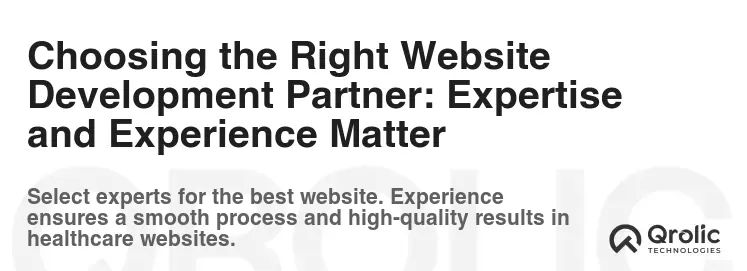
Selecting the right website development partner is a crucial decision that can significantly impact the success of your online presence.
What to Look for in a Healthcare Website Development Agency
- Experience: Look for an agency with experience in developing websites for healthcare providers. They should understand the unique challenges and requirements of the healthcare industry.
- Expertise: Ensure the agency has expertise in user-centric design, SEO, HIPAA compliance, and other key areas.
- Portfolio: Review the agency’s portfolio to see examples of their previous work.
- Testimonials: Read testimonials from other healthcare providers who have worked with the agency.
- Communication: Choose an agency that communicates clearly and effectively throughout the development process.
- Pricing: Get quotes from multiple agencies and compare their prices and services.
- Support: Ensure the agency offers ongoing support and maintenance after your website is launched.
- Understanding of Healthcare Regulations: The agency must understand HIPAA and other relevant healthcare regulations. They need to demonstrate how they will ensure your website is compliant.
Questions to Ask Potential Website Development Partners
- What experience do you have in developing websites for healthcare providers?
- Can you show me examples of your previous work in the healthcare industry?
- How will you ensure my website is HIPAA compliant?
- What is your approach to user-centric design?
- How will you optimize my website for search engines?
- What is your process for testing and quality assurance?
- What kind of support and maintenance do you offer after my website is launched?
- What is your pricing structure?
- Who will be my point of contact during the development process?
- What is your timeline for completing the project?
Qrolic Technologies: Your Partner in Healthcare Website Development

Qrolic Technologies understands the unique needs and challenges of healthcare providers. We specialize in creating custom websites that are user-friendly, SEO-optimized, and HIPAA compliant. Our team of experienced designers, developers, and SEO experts is dedicated to helping you build a strong online presence and attract more patients.
Why Choose Qrolic Technologies for Your Healthcare Website?
- Healthcare Expertise: We have extensive experience in developing websites for healthcare providers of all sizes, from small clinics to large hospitals.
- User-Centric Design: We create websites that are designed with your patients in mind, making it easy for them to find the information they need and book appointments.
- SEO Optimization: We optimize your website for search engines to help you rank higher in search results and attract more organic traffic.
- HIPAA Compliance: We understand the importance of protecting patient privacy and ensure your website is HIPAA compliant.
- Custom Solutions: We offer custom website development solutions tailored to your specific needs and budget.
- Ongoing Support: We provide ongoing support and maintenance to keep your website running smoothly and securely.
- Focus on Results: We are committed to delivering results and helping you achieve your business goals.
- Transparent Communication: We believe in clear and open communication throughout the entire development process.
Our Healthcare Website Development Services Include:
- Website Design and Development: We create custom website designs that are visually appealing and user-friendly.
- Content Creation: We write clear, concise, and informative content that engages your target audience.
- SEO Optimization: We optimize your website for search engines to help you rank higher in search results.
- Online Appointment Scheduling Integration: We integrate online appointment scheduling systems to streamline the patient experience.
- Patient Portal Development: We develop secure patient portals that allow patients to access their medical records and communicate with their providers.
- HIPAA Compliance Consulting: We provide HIPAA compliance consulting to ensure your website is compliant with all relevant regulations.
- Website Maintenance and Support: We offer ongoing website maintenance and support to keep your website running smoothly and securely.
Let Qrolic Technologies help you create a website that attracts new patients, enhances patient engagement, and streamlines your operations. Contact us today for a free consultation. Visit our website at https://qrolic.com/ to learn more.
The Future of Healthcare Websites: Trends to Watch

The landscape of healthcare websites is constantly evolving, with new technologies and trends emerging all the time. Here are some trends to watch in the coming years:
- Artificial Intelligence (AI): AI-powered chatbots and virtual assistants can provide patients with instant answers to their questions and help them navigate your website.
- Personalized Experiences: Websites will become more personalized, tailoring content and recommendations to individual patient needs.
- Telehealth Integration: Websites will increasingly integrate with telehealth platforms, allowing patients to connect with their providers remotely.
- Voice Search Optimization: Optimizing your website for voice search will become increasingly important as more people use voice assistants like Siri and Alexa.
- Data Security: With increasing cyber threats, data security will remain a top priority for healthcare websites.
- Improved Accessibility: Websites will become even more accessible to people with disabilities.
- Video Content: Video will continue to be a dominant form of content, with more healthcare providers using video to educate and engage patients.
- Mobile-First Design: Mobile-first design will become even more critical as mobile devices continue to dominate web traffic.
By staying ahead of these trends, you can ensure that your healthcare website remains relevant and effective in the years to come. Investing in a professional website is an investment in the future of your practice.
